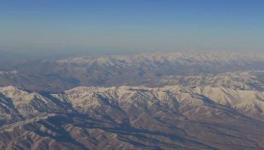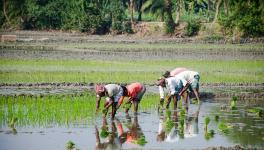River Linking is a Prestige Project, will not Solve Water Crisis

Image Courtesy: The Wire
The Union Cabinet has approved the controversial Rs. 44,605 crore Ken-Betwa River Link Project (KBRLP). Officially, this project is touted to have several benefits, including generating 103 MW hydroelectric power and 27 MW solar power, irrigating 10.62 lakh hectares of land and providing drinking water to 60 lakh people. The project involves the construction of the Daudhan Dam on the Ken river to take some of its declared “surplus” water to the Betwa river using a 230-km canal. The project is sought to be completed by a Special Project Vehicle (SPV), the Ken-Betwa Link Project Authority, in eight years.
Before Cabinet approval, the Union Jal Shakti Minister and the chief ministers of the two states involved—Madhya Pradesh and Uttar Pradesh—had reached an agreement on 22 March 2021. Over time, some projects including the Lower Orr, Kotha Barrage etc., were added to this project.
The government also claims the KBRLP will pave the way for the larger project to interlink more rivers. The government has discussed around 30 projects of this highly contentious river inter-linking project. About two decades ago, the cost of overall river-linking was about 13 times the current cost of the KBRLP. This cost estimate is sure to have risen since then. As the first of this series of projects, the stakes for the KBRLP are very high for the government and the powerful construction lobby.
Unfortunately, the government has chosen to ignore severe adverse aspects of this project that independent experts and even official committees, including the Central Empowered Committee of the Supreme Court, have pointed out. Some of these objections still stand in the way of obtaining the required legal clearances for this project. These objections make it clear that the government cannot justify the construction of this project on grounds of viability and real assured benefits. Now, it is promoting inter-linking more as a prestige project, and as the starting point of the project to link all rivers.
It is shocking that the government promoted the KBRLP, which involves felling lakhs of trees, mostly in the Panna Tiger Reserve. Some estimates of trees threatened by this project are even higher. The Central Empowered Committee of the Supreme Court (CEC) notes, “The Sub-Committee of the Forest Advisory Committee in its Report has stated that the total number of trees of 20 cm. and above, which are to be felled is around 23 lakh.” The reference here is to the girth of trees. From the time of this estimate to the implementation, the number of trees of such girth will increase significantly.
The CEC also estimated a loss of 10,500 hectares of wildlife habitat in the Panna Reserve. Habitats of many protected wildlife species are likely to be disrupted if the project goes ahead, despite the claims of taking care of it. Against these heavy ecological costs, the claims of ending water scarcity in Bundelkhand through this project are highly suspect too. The project hopes to achieve this by transferring “surplus” water of the Ken river to the water-deficient Betwa. However, Ravi Chopra, founder of People’s Science Institute, who has studied this issue, has found that considering the Ken and Betwa basins are adjacent, they have similar weather and rainfall patterns. They experience droughts and floods simultaneously. Hence, the concept of surplus to deficit area is meaningless. The hydrological data used to justify such a huge project was also not shared in a transparent manner and appears old.
Besides, the Ken river has been under the onslaught of illegal sand mining in recent times. The locals, even government officials, have repeatedly questioned the basic premise of this project: that the Ken has surplus water for transferring to the Betwa. Any project based on unconfirmed claims only sows the seeds of future problems and tensions.
While travelling in the Bundelkhand region, this author learnt about the heavy depletion and harm inflicted not just on the Ken river but even its smaller tributaries by sand-mining. The Ken needs protection, not water transfer from this river. Now, the needs of the population are also growing.
This project is being propagated as highly beneficial to Bundelkhand, a region of 13 districts spread over Uttar Pradesh and Madhya Pradesh. However, studies of water scarcity in Bundelkhand have mentioned deforestation as a leading cause of water scarcity, while the KBRLP is to start with the felling of 23 lakh trees. These studies include a study by the Vigyan Shiksha Kendra and IIT Delhi of the water scarcity of the Bundelkhand region. A key person involved in this study, Dr Bhartendu Prakash, followed up with an updated study documenting alternative approaches based on water conservation especially suited to local conditions.
How Bundelkhand will benefit from Ken-Betwa linking is not clear at all. Nearly ten thousand people spread over about ten villages are likely to be displaced as per the details of this project. The multiple problems caused by dam construction are widely known, from submerged villages to loss of livelihood. These were depicted in the acclaimed Hindi novels ‘Doob’ and ‘Paar’ by Virendra Jain. From time to time, destructive floods in Bundelkhand have been blamed on the arbitrary release of excess water from dams, as this writer witnessed in Chitrakut and around.
Bundelkhand is known for its rich legacy of traditional water sources, including tanks constructed by the Chandela kings in Mahoba. The wealth of traditional water sources, particularly in Mahoba, Chattarpur and Tikamgarh, has sparked discussions on planning and constructing water management means that suit local conditions. The repair and maintenance of these sources can play an essential role in solving water scarcity. Even today, travelling from Chirakut to Allahabad one can see water conservation efforts that have helped people combat the water crisis for decades together.
Some of these projects supported by Srijan are in the Banda, Mahoba and Chitrakut districts. Some projects supported by Action India, NABARD and Oxfam, are in the Patha area. The government can take up thousands of such initiatives at a fraction of the cost of KBRLP, without any adverse environmental effects.
A letter signed by 30 experts and activists had been in the news earlier as it registered a strong protest against this project and the arbitrariness involved in its implementation. This letter says, “The project has been plagued by sloppy, intentionally misleading and inadequate impact assessments, procedural violations and misinformation at every step of the way.” The signatories include Amita Baviskar, a former member of the Forest Advisory Committee and EAS Sarma, former Secretary, Government of India. This letter says basic information about water availability in the two rivers has not been provided or held back from the project-affected people.
The writer is a journalist and author. His recent books include Man over Machine (Gandhian Ideas For Our Times ) and Protecting Earth for Children. The views are personal.
Get the latest reports & analysis with people's perspective on Protests, movements & deep analytical videos, discussions of the current affairs in your Telegram app. Subscribe to NewsClick's Telegram channel & get Real-Time updates on stories, as they get published on our website.
























